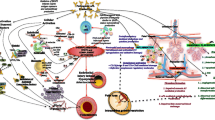Abstract
The antiphospholipid syndrome (APS) is characterized by arterial and/or venous thromboses, pregnancy loss, and the presence of anticardiolipin antibodies. The pathogenic mechanisms that lead to these clinical manifestations are incompletely understood. Although a direct pathogenic role of antiphospholipid antibodies has been established, including their role in endothelial cell and platelet activation, there is growing evidence that activation of the complement pathway may contribute to the pathogenesis of APS. Vital information has been obtained from studies exploring the features of pregnancy morbidity and thrombosis using complement deficient murine models. These studies are providing the foundation for the development of new therapeutic options to optimize the management of APS.
Similar content being viewed by others
References
Kim YU, Kinoshita T, Molina H et al (1995) Mouse complement regulatory protein Crry/p65 uses the specific mechanisms of both human decay-accelerating factor and membrane cofactor protein. J Exp Med 181(1):151–159, January 1
Xu C, Mao D, Holers VM, Palanca B, Cheng AM, Molina H (2000) A critical role for murine complement regulator crry in fetomaternal tolerance. Science 287(5452):498–501, January 21
Lockshin MD, Sammaritano LR, Schwartzman S (2000) Validation of the Sapporo criteria for antiphospholipid syndrome. Arthritis Rheum 43(2):440–443, February
Holers VM, Girardi G, Mo L et al (2002) Complement C3 activation is required for antiphospholipid antibody-induced fetal loss. J Exp Med 195(2):211–220, January 21
Girardi G, Berman J, Redecha P et al (2003) Complement C5a receptors and neutrophils mediate fetal injury in the antiphospholipid syndrome. J Clin Invest 112(11):1644–1654, December
Kirchhofer D, Moran P, Bullens S, Peale F, Bunting S (2005) A monoclonal antibody that inhibits mouse tissue factor function. J Thromb Haemost 3(5):1098–1099, May
Pawlinski R, Pedersen B, Erlich J, Mackman N (2004) Role of tissue factor in haemostasis, thrombosis, angiogenesis and inflammation: lessons from low tissue factor mice. Thromb Haemost 92(3):444–450, September
Shamonki JM, Salmon JE, Hyjek E, Baergen RN (2007) Excessive complement activation is associated with placental injury in patients with antiphospholipid antibodies. Am J Obstet Gynecol 196(2):167.e1–167e.5, February
Stone S, Pijnenborg R, Vercruysse L et al (2006) The placental bed in pregnancies complicated by primary antiphospholipid syndrome. Placenta 27(4-5):457–467, April
Pierangeli SS, Girardi G, Vega-Ostertag M, Liu X, Espinola RG, Salmon J (2005) Requirement of activation of complement C3 and C5 for antiphospholipid antibody-mediated thrombophilia. Arthritis Rheum 52(7):2120–2124, July
Oku K, Atsumi T, Bohgaki M et al (2008) Complement activation in patients with primary antiphospholipid syndrome. Ann Rheum Dis, July 14. doi:10.1136/ard.2008.090670
Peerschke EI, Yin W, Grigg SE, Ghebrehiwet B (2006) Blood platelets activate the classical pathway of human complement. J Thromb Haemost 4(9):2035–2042, September
Simpson R, Alon R, Kobzik L, Valeri CR, Shepro D, Hechtman HB (1993) Neutrophil and nonneutrophil-mediated injury in intestinal ischemia-reperfusion. Ann Surg 218(4):444–453, October
Crawford MH, Grover FL, Kolb WP et al (1988) Complement and neutrophil activation in the pathogenesis of ischemic myocardial injury. Circulation 78(6):1449–1458, December
Carter RH, Fearon DT (1992) CD19: lowering the threshold for antigen receptor stimulation of B lymphocytes. Science 256(5053):105–107, April 3
Fleming SD, Shea-Donohue T, Guthridge JM et al (2002) Mice deficient in complement receptors 1 and 2 lack a tissue injury-inducing subset of the natural antibody repertoire. J Immunol 169(4):2126–2133, August 15
Fleming SD, Egan RP, Chai C et al (2004) Anti-phospholipid antibodies restore mesenteric ischemia/reperfusion-induced injury in complement receptor 2/complement receptor 1-deficient mice. J Immunol 173(11):7055–7061, December 1
Williams JP, Pechet TT, Weiser MR et al (1999) Intestinal reperfusion injury is mediated by IgM and complement. J Appl Physiol 86(3):938–942, March
Stahl GL, Xu Y, Hao L et al (2003) Role for the alternative complement pathway in ischemia/reperfusion injury. Am J Pathol 162(2):449–455, February
Derksen RH, Khamashta MA, Branch DW (2004) Management of the obstetric antiphospholipid syndrome. Arthritis Rheum 50(4):1028–1039, April
Edens RE, Linhardt RJ, Bell CS, Weiler JM (1994) Heparin and derivatized heparin inhibit zymosan and cobra venom factor activation of complement in serum. Immunopharmacology 27(2):145–153, March
Weiler JM, Edens RE, Linhardt RJ, Kapelanski DP (1992) Heparin and modified heparin inhibit complement activation in vivo. J Immunol 148(10):3210–3215, May 15
Kazatchkine MD, Fearon DT, Metcalfe DD, Rosenberg RD, Austen KF (1981) Structural determinants of the capacity of heparin to inhibit the formation of the human amplification C3 convertase. J Clin Invest 67(1):223–228, January
Girardi G, Redecha P, Salmon JE (2004) Heparin prevents antiphospholipid antibody-induced fetal loss by inhibiting complement activation. Nat Med 10(11):1222–1226, November
Author information
Authors and Affiliations
Corresponding author
Additional information
Sources of Funding
ACR/REF Lupus Investigator Fellowship Award and W81XWH-07-1-0286 from Medical Research and Materiel Command.
Rights and permissions
About this article
Cite this article
Avalos, I., Tsokos, G.C. The Role of Complement in the Antiphospholipid Syndrome-Associated Pathology. Clinic Rev Allerg Immunol 36, 141–144 (2009). https://doi.org/10.1007/s12016-008-8109-7
Published:
Issue Date:
DOI: https://doi.org/10.1007/s12016-008-8109-7




